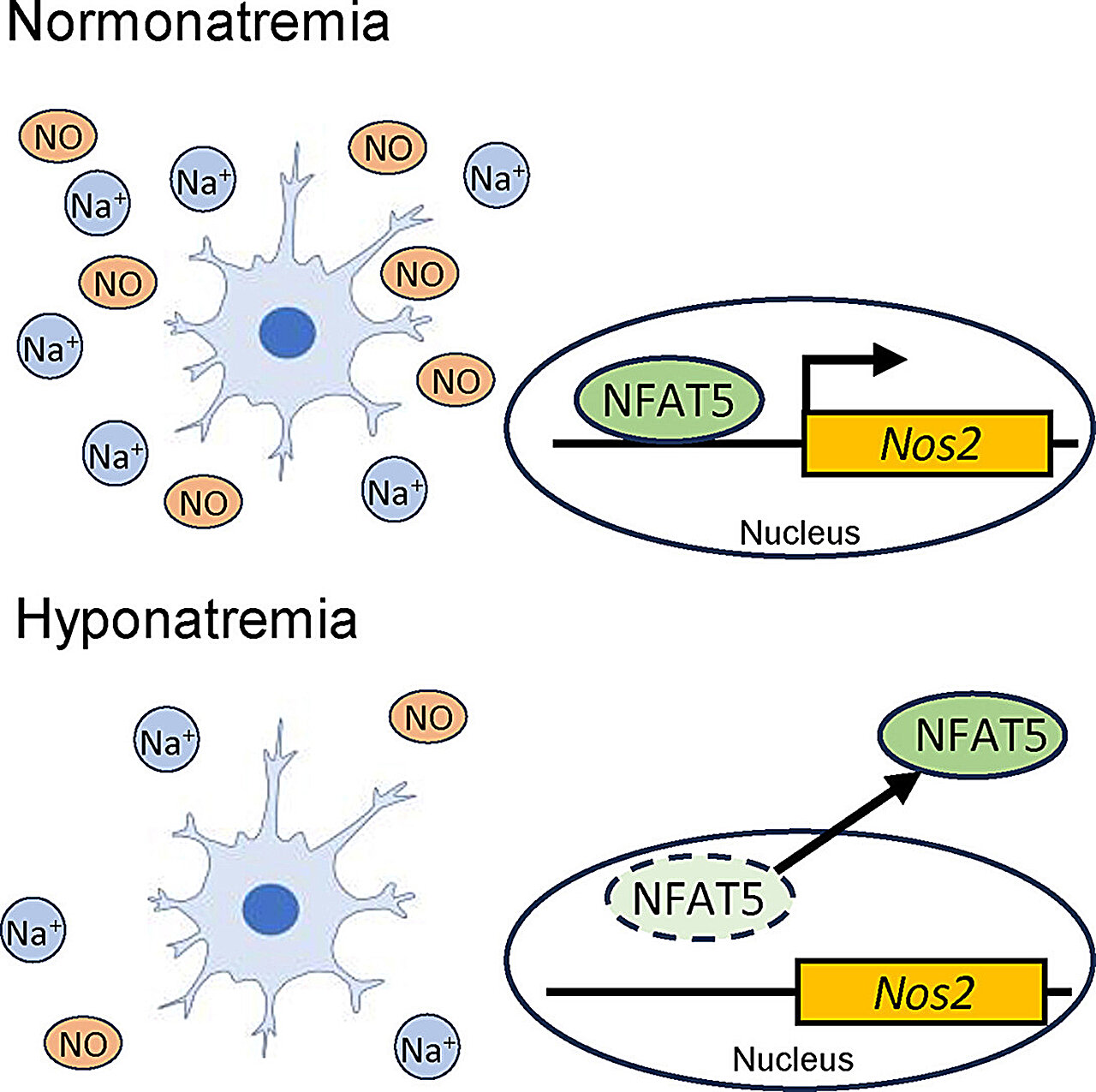In a new study, scientists investigated the impact of low sodium concentrations and their rapid correction on nitric oxide production, depending on the expression of Nfat5 in microglial cells. Credit: Yoshihisa Sugimura of Fujita Health University
Low serum sodium concentrations in the blood are called hyponatremia, a common clinical electrolyte disorder. Unlike acute hyponatremia, chronic hyponatremia was previously considered asymptomatic because the brain can successfully adapt to hyponatremia. If chronic hyponatremia is not treated, it can lead to complications such as fractures, falls, memory impairment and other mental problems.
However, treating the chronic condition is quite difficult as it has been observed that correcting hyponatremia too quickly can cause ODS. It is a neurological disorder in which nerve transmission is affected due to damage in the myelin sheath surrounding neurons and is associated with neurological morbidity and mortality.
To ensure that hyponatremia is addressed without the complications associated with the treatment process, it is necessary to understand the origins of ODS. In a previous study, Professor Yoshihisa Sugimura from the Department of Endocrinology, Diabetes and Metabolism, School of Medicine of Fujita Health University found that microglia, resident immune cells in the brain and spinal cord, could play a crucial role in the pathogenesis of osmotic diseases. demyelination syndrome (ODS).
Building on these findings, a team of researchers led by Prof. Sugimura, with Haruki Fujisawa as first author, now investigated the direct impact of low extracellular sodium (LS) concentrations and their rapid correction on microglia. The research was published in Free Radical Biology and Medicine and is co-authored by Haruki Fujisawa and Atsushi Suzuki of Fujita Health University, among others. In this study, the research team showed that low sodium levels could reduce specific mRNA expression and nitric oxide (NO) production of microglia.
Microglia participate in many critical functions of the central nervous system, ranging from neurogenesis to synaptic remodeling and myelination, through movement and surveillance in the brain. They can activate in response to external stimuli or the presence of pathogens and produce various chemicals, including nitric oxide, that can cause inflammation.
“Understanding the rather elusive effect of chronic hyponatremia and its rapid correction on microglia is crucial as it could be a potential therapeutic target for ODS and hyponatremia-related neurocognitive disorders and mental manifestations,” explains Prof. Sugimura when asked to the reason behind the focus on microglia. for the study.
To investigate the effect of LS, the team chose microglial cell lines (BV-2 or 6–3). They found that a reduction in sodium concentrations of 36 mmol/L suppressed the mRNA expression of Nos2, an enzyme responsible for catalyzing and moderating the production of NO, which is essential for inflammation and regulating neurotransmission. This was further reflected in the experiments performed under LS conditions, where the researchers noted reduced production of NO in microglial cells.
Furthermore, LS suppressed the expression of nuclear factor of activated T cells-5 (NFAT5), a protein responsible for regulating the expression of genes that deal with osmotic stress. Furthermore, overexpression of NFAT5 significantly increased Nos2 mRNA expression and NO production in BV-2 cells.
Furthermore, when these microglial cell lines were exposed to rapid correction of low sodium concentrations, the researchers observed a significant increase in NO production. This suggests that acute correction of hyponatremia contributes to the sudden increase in Nos2 mRNA expression, and thus NO release, leading to ODS pathophysiology.
The team also found that expressions of Nos2 and Nfat5 mRNA were also suppressed in microglia isolated from the cerebral cortex in model mice with chronic hyponatremia.
In summary, these findings report the impact of chronic hyponatremia and its rapid correction on microglia, further indicating its contribution to hyponatremia-induced neuronal dysfunctions.
“Clarifying the effect of chronic hyponatremia on brain functions may contribute to the development of new therapies and technology to address this condition, while also reducing the occurrence of associated complications and improving patients’ quality of life,” concludes Prof. Sugimura.
More information:
Haruki Fujisawa et al., Long-term extracellular low sodium concentrations and subsequent their rapid correction modulate nitric oxide production dependent on NFAT5 in microglia, Free Radical Biology and Medicine (2024). DOI: 10.1016/j.freeradbiomed.2024.08.019
Quote: Investigating the effect of low sodium concentrations on microglial cells in the brain (2024, September 18), retrieved September 18, 2024 from https://medicalxpress.com/news/2024-09-exploring-effect-sodium-brain-microglial .html
This document is copyrighted. Except for fair dealing purposes for the purpose of private study or research, no part may be reproduced without written permission. The content is provided for informational purposes only.





















